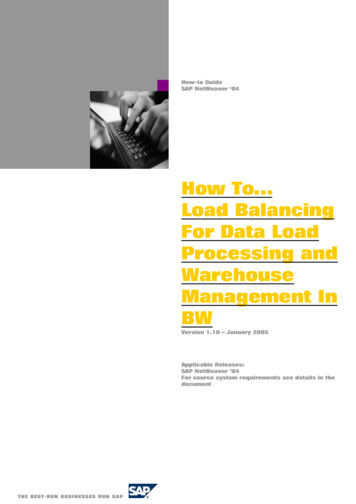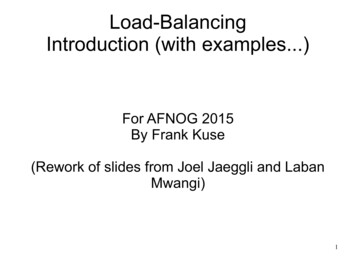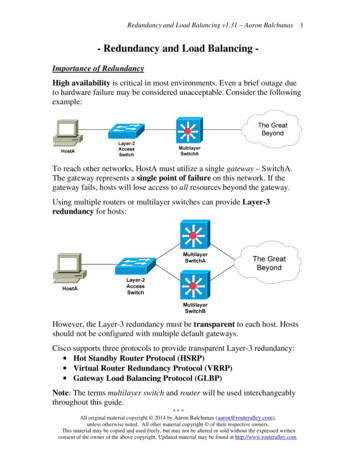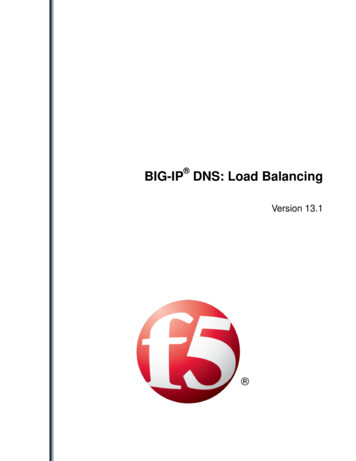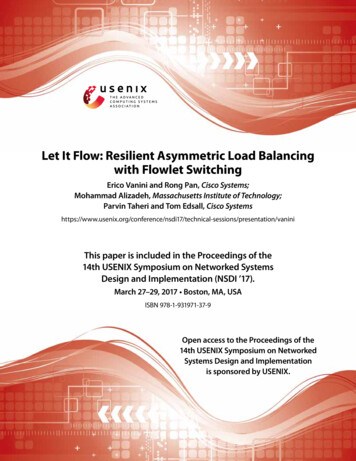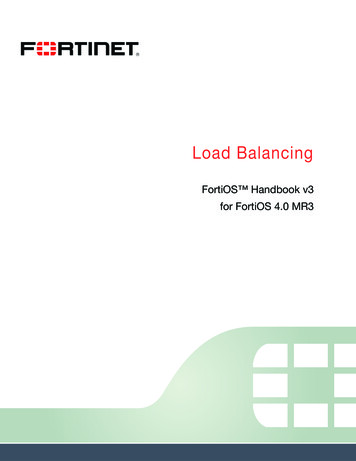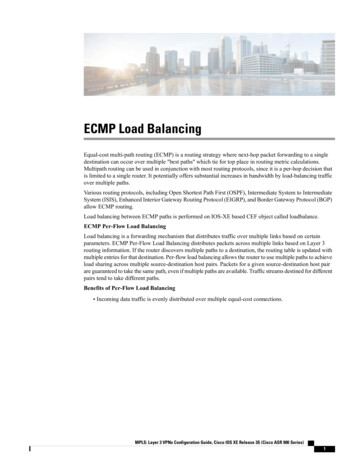
Transcription
Load Balancing with Migration Penalties ElectricalVivek F. Farias , Ciamac C. Moallemi , and Balaji Prabhakar †Engineering, Stanford University, Stanford, CA 94305, USA Emails: {vivekf,ciamac,balaji}@stanford.edu† Computer Science, Stanford University, Stanford, CA 94305, USAAbstract— Many practical systems perform load balancing.The main aim of load balancing is to utilize the capacity of asystem of parallel processors efficiently and to reduce the delayof processing jobs. This paper is concerned with load balancing,or process migration, when there is a penalty associated withmigration.We consider the following model: Jobs arrive at each of nparallel servers. An arriving job can either be processed in aunit of time, on average, at the server where it arrives, or it canmigrate to another server where it creates K 1 independentjobs. When K 1, migrating jobs impose no extra cost andthis problem is considered extensively in the literature. We areinterested in the situation K 1. The problem is to decidewhether a job should migrate or not. On the one hand migrationleads to load balancing and hence reduces backlogs. However, italso leads to the creation of extra work and, hence, to a potentialloss of throughput. We ask: Do there exist simple migrationpolicies that can reduce backlogs while providing the highestthroughput? Somewhat surprisingly, we find that policies like“migrate to the least loaded server” are unstable: they cause aloss of throughput. However, we find that a simple variant of thisrule is stable and leads to a reduction of backlogs.I. I NTRODUCTIONConsider a system consisting of n servers, each with anassociated queue. Jobs arrive according to a Poisson processof rate λ at each queue, and service times are IID exponentialrandom variables with mean 1. In the canonical load balancingproblem, an allocator can choose to re-route an arriving job toa queue different from the one it was intended for. An exampleof such a policy— SQ(d)—is sampling d of the n queues andmoving the arriving job to the shortest of those queues. Usingsuch a policy dramatically reduces the average delay for a jobwith no effect on throughput. Now, consider the case wherejob migration incurs a penalty.One way to formalize such a notion is converting a singleexp(1) job into K 1 independent exp(1) jobs in the eventthe job is transferred to a queue different from its originaldestination (see Figure 1). Since load-balancing now addswork to the system it is intuitive to expect that policiesthat allow for too much migration might result in a loss ofthroughput. In fact, we will show that the natural extension ofthe SQ(d) policy, wherein in addition to picking the shortestof d sampled queues, a job is transferred only if the shortestsampled queue has at least K jobs less than the queue at thepoint of arrival, entails a loss of throughput.The question now is whether it is possible to achieve theadvantages of load balancing (viz. shorter delays) at no costto throughput. We demonstrate such an algorithm: a job istransferred to the shortest of the d sampled queues only ifthe shortest sampled queue has at least a factor α 1 jobsless than the queue at the point of arrival. Thus we show thateven though transferring jobs entails adding more work to thesystem, we may still realize the benefits of load balancingwithout sacrificing throughput.Fig. 1.The model with n 2.Poisson(!)Poisson(!)K Jobs1 Job1 Jobexp(1)exp(1)Our model is a variant of the “supermarket” model considered in [1], [2], [3], [4], which corresponds to the case whereK 1. [1] and [3] independently studied the performance ofSQ(d) in the large-n limit using mean field techniques whereinthe behavior of the system is described by an infinite systemof (deterministic) ODEs. [2] also uses mean-field analysis tostudy a load balancing algorithm that involves, in additionto sampling, the use of memory. The main thrust of thework is in justifying the correctness of the mean-field analysiswhich suggests that these algorithms offer drastic performanceimprovements. The supermarket model itself applies to a broadvariety of interesting problems including dynamic resourceallocation, hashing, etc. as pointed out in [5]. The variantwe consider here lets us capture, in addition, the notion ofa preferred allocation. One well studied example of such aproblem is that of caching in multiprocessor systems whereineach processor has a preferred cache[6].II. M ODELFor this and the following section, we shall consider theembedded discrete-time Markov chains corresponding to thesystems of interest. For integer time indexes t 0, qi (t) isthe amount of work (measured in the number of exp(1) jobequivalents) in the queue for the ith server immediately afterthe tth event. We assume that the system starts empty. Whena job arrives to server i, the server must decide whether toserve the job itself, in which case the job joins the server’s
qi (t 1) qi (t 1) C, then the job is bounced to queue i . Otherwise, the jobjoins the queue at server i. We require that C K.MBOUNCE(α,d): This policy employs a multiplicativethreshold to decide when to share. This threshold hasbeen slightly modified so as not to bounce jobs to anotherqueue when that queue would subsequently have morejobs than the original queue.In this scheme, d queues are also sampled as above.However, the job is only bounced to queue i ifqi (t 1) max(αqi (t 1), qi (t 1) K).Here, we require α 1.The switching region under the ABOUNCE policy is fargreater than that under MBOUNCE (refer to the caricaturein Figure 2) in the following sense. The fraction of states inwhich no migration occurs under the ABOUNCE policy goesto 0 whereas it remains strictly positive under the MBOUNCEpolicy. Intuitively, this suggests that the ABOUNCE policycreates too much work and can therefore be unstable whilethe MBOUNCE policy can be stable. One major purpose ofthis paper is to rigorously prove these statements.Note that in both strategies we allow for d ; in whichcase the shortest sampled queue is assumed to be the shortestqueue in the system.Fig. 2. No-migration region (shaded) for n 2 under ABOUNCE andMBOUNCE 100q210040402020002040608010000q1204060q1III. S TABILITY80100with arrival rate λ and service rate 1. Hence, the system ispositive recurrent if λ 1. Ideally, the system with sharingshould not sacrifice throughput and, thus, we would hope forthe same stability region.Additive ThresholdsFor the ABOUNCE(C,d) strategy, by numerical simulation,we can see that the stability region is strictly smaller than thesystem with no sharing. For example, in Figure 3, we see twosample paths for the ABOUNCE(2,10) system with K 2and n 100. The system is clearly stable when λ 0.77, butunstable when λ 0.79.Fig. 3. Two sample paths for ABOUNCE(2, 10) with n 100 that suggestinstability for λ 0.79.60! 0.79! 0.775040maxi qiqueue, or to “bounce” the job and send K jobs to the queueof another server. We will examine two routing strategies: ABOUNCE(C,d): This policy decides to share based onan additive threshold.When a job arrives at a server i at time t, the serversamples d other queues with replacement. Let i be theindex of the shortest of these queues. If302010001020304050t/3000060708090100The ABOUNCE(C,d) policy, however, is dominated by asystem with no sharing where each job requires service timewhich is the sum of K exp(1) random variables. Such asystem would be stable if λ 1/K. By making this couplingprecise, we can establish the following theorem.Theorem 1: If λ 1/K, then the ABOUNCE(C,d) systemis positive recurrent.Further, in the case of 2 queues and d , we cantheoretically establish shrinkage of the stability region.Theorem 2: If n 2, the ABOUNCE(C, ) system is nullrecurrent or transient if λ λ , where λ 1 is defined by!KC 1 (KC 1)2 4(K 1)(C 2)(C 3) λ .2(K 1)(C 2) Proof: For the λ λ case, we appeal to the variationof Foster’s Criterion in Proposition 5.4 in [7]. In particular,given a function V : Z2 R, define the drift operator( V )(q) E [ V (q(1)) q(0) q] V (q).To establish that the system is null recurrent or transient, itsuffices to find a test function V and a finite set E0 Z2 such that:(I) For all q / E0 , V (q) 0.In this section, we will examine the stability policies of (II) There exists some q / E0 so that for all q E0 ,the various load balancing strategies. In particular, for eachV (q ) V (q).strategy, we are concerned with establishing the set of arrival (III) V is bounded below and for some constant A andrates λ such that the resulting system in positive recurrent.all q E0 ,First, consider the case where no sharing is performed. Here,E [ V (q(1)) V (q(0)) q(0) q] A.the system trivially splits into n independent M/M/1 queues
Consider the test functionV (q) q1 q2 1 λ1 λC"! 0 q1 q2 # ,and set E0 {(0, 0)}. This function clearly satisfies conditions (II) and (III). Define the following sets, for 0 # C,# A q Z2 E0 : q1 q2 C ,# B! q Z2 E0 : q1 q2 #, q1 , q2 0 .By separately considering the drift ( V )(q) in each of thesesets, it can be verified that for λ λ , condition (I) also holds.In a system with n 2 and K 2 under theABOUNCE(2, ) policy, for example, Theorems 1 and 2indicate stability when λ 0.5 and instability when λ 0.89.Multiplicative ThresholdsThe MBOUNCE(α,d) strategy, on the other hand, intuitivelybounces less and less as the system gets more and more loaded(see Figure 2). To see this, consider the n 2 case. If onequeue is more loaded than the other, bounces will occur andthe queues will be equalized. As the levels of the queuesincrease, it takes more and more time for them to becomeunequal by a constant fraction again, and hence bouncingdecreases. The following theorem establishes that, because ofthis behavior, MBOUNCE(α,d) maintains the same stabilityregion as not sharing. The proof is deferred until the appendix.Theorem 3: MBOUNCE(α,d) is stable for all λ 1.IV. D ELAY - F ORMAL M EAN F IELD A NALYSISWe now turn our attention to queuing delay. We approachthis in two ways. We will present simulation results in the nextsection. Here we will present a formal mean-field analysis.Such an analysis permits us to answer questions about rareevents in large systems (which is difficult to do via simulation).In particular, we study tail behavior for systems with nlarge. In this section we revert to considering continuous-timeMarkov processes as opposed to the embedded chains of theprevious section.Multiplicative ThresholdsConsider the Markov chain corresponding for a system of nqueues under the MBOUNCE(d,α) policy. Let mi (τ ) denotethe number of queues with at least i jobs at time τ and observethat the sequence (mi )i 0 suffices to describe the state of thechain at time τ . For ease of exposition we make the assumptionthat α is integral. It then follows that for i K and τ small,E[mi (τ τ ) mi (τ ) mi (τ )] (λ τ ) (mi 1 (τ ) mi (τ )) (m i/α% 1 (τ )/n)dK 1%" (λ τ )mα(i K m) (τ ) (mi K m (τ )/n)d m 0&(mi K m 1 (τ )/n)d ( τ ) (mi (τ ) mi 1 (τ )) ,where the first term in the summation corresponds to arrivalsat a queue with i 1 jobs, the second term corresponds tojobs that are bounced to queues with between i K and i 1jobs, whereas the last term corresponds to departures from aqueue with i jobs. Setting τ 1/n, we have:E[mi (τ τ )/n mi (τ )/n mi (τ )] τ(λ τ ) (mi 1 (τ )/n mi (τ )/n) (m i/α% 1 (τ )/n)dK 1%" (λ τ )mα(i K m) (τ )/n (mi K m (τ )/n)d m 0&(mi K m 1 (τ )/n)d ( τ ) (mi (τ )/n mi 1 (τ )/n) .Letting limn E[mi (τ )/n] si (τ ), and noting that bythe Law of Large Numbers, limn mi (τ )/n si (τ ), we(formally) have that for large n, the MBOUNCE(d, α) systemis described by the following system of ODEs:ṡi (τ ) λ (si 1 (τ ) si (τ )) sd i/α% 1 (τ ) λK 1"m 0'(sα(i K m) (τ ) sdi K m (τ ) sdi K m 1 (τ ) (si (τ ) si 1 (τ )) , i K, τ 0,ṡi (τ ) λ (si 1 (τ ) si (τ )) λi 1"m 0'(smax(m K,αm) (τ ) sdm (τ ) sdm 1 (τ ) (si (τ ) si 1 (τ )) ,s 0 (τ ) 0, τ 0,s0 (0) 1,si (0) 0, i 0. 0 i K, τ 0,(1)Fixed points of this system of ODEs have the followingproperty which suggests that for large n, the MBOUNCE(d,α) system has far lighter tails than a system with no sharing.Lemma )1: Any fixed point of the system of equations (1), satisfying i 0 si and si 0 i must also satisfy: *ilogα (d 1) 1d.si O (λ(1 %))for arbitrary % 0.Additive ThresholdsSimilar reasoning as the multiplicative case suggests thefollowing system of differential equations for the tails of anABOUNCE(d) system with n large:ṡi (τ ) λ (si 1 (τ ) si (τ )) sdi K 1 (τ ) K 1"m 0'(λsi m (τ ) sdi K m (τ ) sdi K m 1 (τ ) (si (τ ) si 1 (τ )) , i K, τ 0,
ṡi (τ ) λ (si 1 (τ ) si (τ )) λsm K (τ )m 0'sdm (τ ) (sdm 1 (τ ) 0 i K, τ 0, (2) (si (τ ) si 1 (τ )) ,s 0 (τ ) 0, τ 0,s0 (0) 1,si (0) 0, i 0.λ 0.70 (MBOUNCE)λ 0.75 (MBOUNCE)λ 0.80 (MBOUNCE)λ 0.85 (MBOUNCE)λ 0.70 (No Sharing)λ 0.75 (No Sharing)λ 0.80 (No Sharing)λ 0.85 (No Sharing)10for arbitrary % 0.V. D ELAY - N UMERICAL R ESULTSIn Figures 4 and 5, we can see empirical queue sizetails for the ABOUNCE(C,d) and MBOUNCE(α,d) policiesas compared with no sharing. In both cases, a significantFig. 4. Queue-size tails for ABOUNCE(10, C) vs. tails under no sharing.(n 100, λ 0.75, K 2)010 110 210Pr(q1 i)Fig. 6. Empirical expected delay for MBOUNCE(α,10) policy with varyingα versus no sharing. (n 100, K 2)11Fixed points of this system of ODEs have the followingproperty which suggests that for large n, the ABOUNCE(d)system has lighter tails than both the system with no sharingas well as the MBOUNCE(d, α) system for large n. Ofcourse, we also know from the previous section that such animprovement in tail behavior comes at a cost to throughput.Lemma )2: Any fixed point of the system of equations (2), satisfying i 0 si and si 0 i must also satisfy: *(d 1)#i/2(K 1) 1d.si O (λ(1 %))98765432111.522.53α3.544.55VI. C ONCLUSIONWe have presented two algorithms for load balancing whenthere is a cost to transferring jobs. The use of the MBOUNCEalgorithm provably entails no loss in throughput. Simulationresults, as well as a formal mean-field analysis stronglysuggest that this algorithm affords improvements in waitingtime as well as lighter queue-tails than the no-sharing case.Several issues remain:1) Can the mean field analysis of section IV be maderigorous? The large deviations techniques used in [2]do not appear to extend.2) Is there an ‘optimal’ decision boundary to decide between sharing and not-sharing a job?ACKNOWLEDGMENTS 310 410C 2C 3C 4C 5No sharing 510 610improvement is seen versus the policy of not sharing. Further,the multiplicative threshold policies offer better performancethan additive policies for this system.Expected Delayi 1"1234567iThe first author was supported by a supplement to NSFGrant ECS-9985229 provided by the MKIDS Program. Thesecond author was supported by a Benchmark Stanford Graduate Fellowship. The authors wish to thank Devavrat Shah andChandra Nair for helpful discussions.R EFERENCESFig. 5. Queue-size tails for MBOUNCE(10, α) vs. tails under no sharing.(n 100, λ 0.75, K 2)010 110 210 31Pr(q i)10 410 510α 1.4α 2.0α 2.6No sharing 610 710 81012345i678[1] M. Mitzenmacher, “The power of two choices in randomized loadbalancing,” Ph.D. dissertation, University of California, Berkeley, 1996.[2] M. Mitzenmacher, B. Prabhakar, and D. Shah, “Load balancing withmemory,” in Proceedings of FOCS, 2002.[3] N. Vvedenskaya, R. Dobrushin, and F. Karpelevich, “Queueing systemwith selection of the shortest of two queues: An asymptotic approach,”Problems of Information Transmission, vol. 32, no. 1, pp. 15–29, 1996.[4] C. Nair, B. Prabhakar, and D. Shah, “The randomness in randomizedload balancing,” in Proceedings of the 39th Annual Allerton Conferenceon Communication, Control and Computing, October 2001, pp. 912–921.[5] Y. Azar, A. Z. Broder, A. R. Karlin, and E. Upfal, “Balanced allocations,”SIAM J. Comput., vol. 29, no. 1, pp. 180–200, 2000.[6] M. S. Squiillante and E. D. Lazowska, “Using processor-cache affinityinformation in shared-memory multiprocessor scheduling,” IEEE Trans.Parallel Distrib. Syst., vol. 4, no. 2, pp. 131–143, 1993.[7] S. Asmussen, Applied Probability and Queues, 2nd ed. Springer-Verlag,2003.
A PPENDIX : P ROOF OF T HEOREM 3We use the Lyapunov function V (q) V1 (q) V2 (q) where,V1 (q) n"qi2 ,(1 pB )i 1andV2 (q) nn1 " "2(qi qj ) .α 1 i 1 j i 1To prove positive recurrence (i.e. stability) for the MBOUNCEMarkov chain (see Proposition 5.3 in [7]), it will suffice toshow for some % 0 that ( V )(q) % for all q / K whereK is some compact set.For ease of exposition, we will assume for the balance ofthis proof that α 2. The same technique can be applied forother α. We also assume, without loss of generality, that thequeues are numbered so that at time 0, qi qj for i j; inthe event of ties we assign the queue with a higher numberprior to re-numbering, the higher number. In particular, afterrenumbering q1 is the longest queue, while qn is the shortest.We define the event En {q1 2qn } { q1 qn K}. Thatis, En is the event that no transfer or arriving jobs is possibleat the next epoch.It is then straightforward to check that for q En ,n( V )(q) 2 λ 1"qi C1 ,N λ 1 i 1(3)where C1 is a constant depending on n, λ.Now, for m {1, . . . , n 1}, define Em {qm 2qn , qm qn K} { qm 1 2qn } { qm 1 qn K}. Essentially,Em is the event wherein a transfer of job is possible and theshortest queue from which a transfer is possible is qm . Further,define,, *,pj,m P argmin qi j ,, Em ,i Swhere S is the set of indexes of the d queues sampled inthe event of an arrival. Thus pj,m is the probability that theshortest of the d queues sampled is queue j (breaking ties infavor of the higher numbered queue). An elementaryargument)nthen gives pj,m pj 1,m . Also, let pB j m 1 pj,m . Itis readily checked that for q Em :( V1 )(q) n"1 λ 1qinλ 1i m 1m %n".λ/n - " 2pj,m Kqj 2(1 pB )qiλ 1i 1j m 1&1/n 2qi C1,m .λ 1(II) Consider an arrival to qi , 1 i m. We get thefollowing positive contribution to the expectation for whenit is unsuccessful in transferring its job:(4)We now consider ( V2 )(q). In evaluating ( V2 )(q) for q Em , we make the following observations:(I) It is straightforward to check that departures from qi , 1 i n or arrivals to qi , m 1 i n contribute at most aconstant to the expectation.n"λ/n2(qi (0) qj (0)).λ 1j i 1However, this contribution is negated by arrivals to queuesnumbered j i,mn&" 2(1 pB )λ % "(qi (0) qj (0)) (qi (0) qj (0))n(λ 1)j i 1j m 1Now, consider the situation where i is successful at transferringits job to some queue. This transfer reduces the difference inlengths between i and the queue it transfers its job to, whichresults in the following negative contribution nλ/n "2pj,m Kqj (0).λ 1 j m 1The difference in queue lengths between the queue to whichi transferred its job and the queues below it increases, whichcontributes the following positive term to the expectation:nn"λ/n "pj,m2K(qj (0) q! (0)).λ 1 j m 1(5)! j 1This term is negated since transfers from i reduce the difference in queue lengths between queues receiving a transfer andlarger queues in {m 1, . . . , n} contributing:j 1n" λ/n "pj,m2K(qj (0) q! (0)).λ 1 j m 1(6)! m 1(We conclude (5) (6) 0 using pj,m pj 1,m .)Putting these observations together, we have that an arrivalto qi , 1 i m contributes to the expectation, a term upperbounded by: n"λ/n 2pj,m Kqj (0) C.λ 1 j m 1Putting our observations together yields that for q Em mn""λ/n( V2 )(q) 2pj,m Kqj C2,m . (7)λ 1
Load Balancing with Migration Penalties Vivek F. Farias , Ciamac C. Moallemi , and Balaji Prabhakar † Electrical Engineering, Stanford University, Stanford, CA 94305, USA Emails: {vivekf,ciamac,balaji}@stanford.edu †Computer Science, Stanford University, Stanford, CA 94305, USA Abstract—Many practical systems perform load balancing. The main aim of load balancing is to
